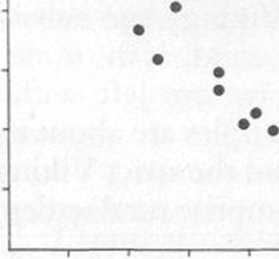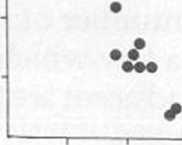31 (444)
56 The Viking Age in Denmark
pig
SO-
A
horse
B
50-

50
cattle

50"
sheep
(Qoat)

Figurę 13 A. Percentages of bonę fragments of, rcspectively, cattle and pig from rural scttlements (Appendix VII). (Sample: cattle, pig, sheep, goat and horse)
Figurę 13 B. Percentages of bonę fragments of, respectivcly, sheep (and goat) and horse from rural settlements (Appendix VII). (Sample as in Fig. 13 A.)
Figurę 13 C. Percentages of bonę fragments of, rcspcctivcly, the cattle-pig and the sheep (and goat)-horsc group from rural settlements (dots), towns (black sąuares), cast Holstein Slavonian fortress-towns (open squares) and fortresses (triangles). (Appendix VII.) (Sample as in Fig. 13 A.)
Both groups supply meat, milk, hides and draught power, though to quite varying degrees. From distribution maps of the ratio cow/pig, it is seen that pigs are dominant in the central Danish provinces, the most forested region, while cows are frcquent in the open lands of west Jylland and east Skane. Apparently the environment determines what meat animal is kept most often, and though cows may graze in woods these are the natural pig area. No elear picture emerges from the sheep/horse ratio, while the distinction between sheep and pig provinces, the sheep being dominant in west Jylland, for instance, is the most obvious of all.
Going back to the sites, it is seen that the towns have morę than 75 per cent cattle and pig bones (and less than 25 per cent sheep, etc.), while the rural settlements have less than 70 per cent cattle/pigs fragments (Fig. 13 and Appendix VII). Among the rural settlements are the Viking Age finds from Viborg and the finds from Lód-dckópinge in west Skane, a possiblc seasonal market. A single pit-housc, also from west Skane (Oxie), has a higher pcrcentage of cattle/pigs than any of the towns, but the deviation here is probably due to the uncertainties of the limited excavation. The Trelleborg fortress in western Sjaelland has percentages of 71 and 29 for the twx> sets, the horse fragments amounting to as much as 14 per cent. Another fortress, Lembecksburg, on the island of Fohr, off the coast of southernmost Jylland, has a cow/pig percentage of 44, less than any village, but a sheep percentage amounting to as much as 55. This site may constitute a third category of consumption, having also an unusual (but still modest) percentage of wild mammals, and many wild birds too. The Slavonian town fortresses in east Holstein, and further to the east, fit into the town cluster of Denmark, perhaps not unexpectedly.
The reason for the distinction between towns and rural settlements seems to be that the meat animals (cattle/pigs) wrcre delivered in the towns (and fortresses), wrhich were not able to meet their demand for food locally. At Hedeby, for instance, only one house has traces of a stall / The percentages of the same animals would then drop in the villages, which kept horses and sheep (but not the wool). It is notcworthy that much the same picture occurs if we omit horses; these, like sheep, are also morę difficult to keep in towns than pigs or even cows.
These observations are important, sińce they link up towns and countryside in the spherc of food output and consumption. The towns were not merely centres of luxury production and trade but were fully integrated on all levels with their surroundings. This is apparent from geographical data as well.
The basie ‘parish division' of Denmark probably took place in the eleventh century. The size of the parishes, as measured by the spread of churches, varies with the quality of the soil, sińce they tend to comprise the same number of souls whether the churches are situated on poor west Jylland soils, with a Iow population density, or on Sjaelland, with a high one. The first borders of the parishes are not known, but we can create hypothetical, and fairly accurate, boundaries by drawing lines, in a right angle, through the mid-points of the lines of sightings between the early medieval churches.
Looking at the homogeneous province in terms of soil around the city of Arhus in Jylland, it appears that the size of the Arhus parish, comprising both agrarians and townsmen, is the same as the other parishes in the area (Fig. 14). This shows that the population in the parish has simply not been able to feed itself from its agricultural area and must have received supplies from the whole province. An identical result is obtained from the city of Ribc.
In the Fledeby area, studies of animal bonę fragments from the town
Wyszukiwarka
Podobne podstrony:
30 (454) 54 The Viking Age in Denmark touch, so the political developmcnt we have described in previ
86 (111) 166 The Viking Age in Denmark 166 The Viking Age in Denmark Figurę 56 Coin-dated silver hoa
57 (213) 108 The Viking Age in Denmark Platę IV. Silvcr and copper dccorated spurs, length about 21
58 (195) 110 The Viking Age in Denmark Platę VI. Sample from late tenth-century silver-hoard at Taru
60 (189) 114 The Viking Age in Denmark Platc X. Ship-sctting and runestonc (on smali mound) at Glave
62 (179) 118 The Viking Age in Denmark Plato XIV. Iron tools from a tenth-ccntury hoard atTjclc, nor
63 (170) 120 The Viking Age in Denmark % Platę XVI Pagc with illustration of an English manuscript f
64 (171) 122 The Viking Age in Denmark Figurc 30 Distribution of wealth in three cemeteries as measu
66 (160) 126 The Viking Age in Denmark have becn fouhd (Figs 32-3).7 They stem from thc same provinc
68 (153) 130 The Viking Age in Denmark two tortoise bucklcs to reprcsent wornen of high standing, th
69 (151) 132 The Viking Age in Denmark heavy cavalry burials, fincr wcapon graves of thc simple type
70 (150) 134 The Viking Age in Denmark cemetcry at Lejre on Sjaelland a dccapitatcd and ticd man was
74 (134) 142 The Viking Age in Denmark 5C~ł silver 800 900 kxx) A.D. Figurę 37 Fluctuations in che r
75 (129) 144 The Viking Age in Denmark Figurę 38 Average weight ofthesilver-hoardsofthe period 900 t
27 (504) 48 The Viking Age in Denmark Europcan meteorological data for earlier per
29 (466) 52 The Viking Age in Denmark We have already mentioned the expansion of grasses, and it is
32 (433) 58 The Viking Age in Denmark and from a rurąl scttlemcnt, Elisenhof, less than fifty kilome
78 (124) 150 The Viking Age in Denmark Figuro 41 Danish coins, c. 800 to 1035 A.D. (1) = ‘Hcdeby’ co
79 (124) 152 The Viking Age in Denmark Roskilde, in the newly won provinces, were the most important
więcej podobnych podstron